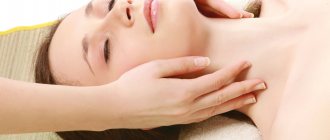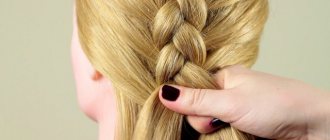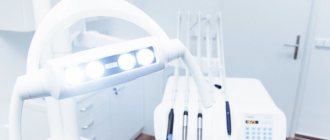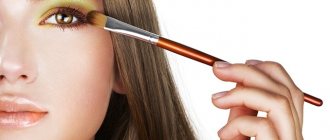Stage I. Detection of postural disorders
How well do you know your body?
Undress, take a comfortable, stable position and evenly distribute your body weight between your right and left legs. Look at yourself using a mirror or video camera from all sides: front, back, side.
You may want to look at yourself some time after class and compare your posture with what it was like. Ask a family member to take a photo of the front, side, and back. Start your inspection from the bottom up, following your gaze from the feet to the head.
Pay attention to the position of the legs, the course of the anal line, the symmetry of the waist triangles, the location of the pelvic wings, costal arches, angles of the shoulder blades, earlobes, etc.
After this, turn your attention to the spine. If you draw an imaginary vertical line from behind through the middle of the back of the head, then with well-balanced curves of the spine it will pass through the middle of all the vertebrae, the pelvis and in the middle between the shoulder blades.
When viewed from the side, pay attention to the evenness of the natural curves of the spine. An imaginary vertical line passing through the external auditory canal should be located behind the knee and hip joints and in front of the ankles (Fig. 75, 76).
Rice. 75. Correct posture. With correct posture, the natural curves of the spine are preserved and muscle tone is minimal
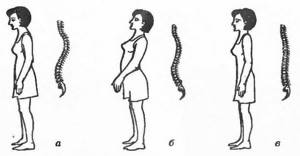
Rice. 76. Types of incorrect posture: a - the spine is excessively curved in the thoracic region; b — the lumbar spine is excessively extended; c - the spine has no natural curves
Also, notice the protrusion of your belly. A noticeably protruding abdomen indicates weakness of the muscles that support the spine in front and affect the degree of curvature of the lumbar lordosis.
Posture is considered physiological if the shins are deviated by 4-5°, the legs are bent at the knee joints by 2-3°, the feet are turned by 30-40°, the distance between the heels is 3-5 cm.
Stage II. Awareness of your capabilities to correct your posture
Once you realize that your posture is not okay, you will want to correct it. However, the smoother you become, the more flaws you notice. Without proper alignment skills of different body parts, you usually put a lot of effort into maintaining the correct position.
This tires and irritates us. Eventually it gets boring, because our lives cannot be completely devoted to correcting our posture.
That is why it is much easier to first master the exercises, which can then be used to develop correct posture and maintain a rational posture at work and at home.
We suggest you master the following set of physical exercises, which will help you feel and understand the capabilities of your body.
Exercise No. 1. Pelvic rocking
Lie on your back, bend your legs at the knees and hip joints (Fig. 77 a).
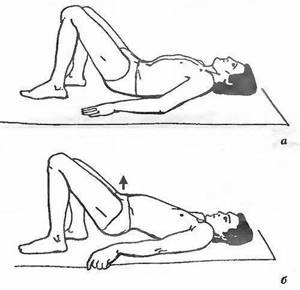
Rice. 77. Pelvic rocking
Lift your pelvis off the bed and straighten your lower back by tensing the spinal extensors. This exercise is made easier by simultaneously protruding the abdomen (Fig. 77 b).
Then flex your lower back by tensing your abdominal and gluteal muscles. This exercise is made easier by drawing in the abdomen.
Pelvic swing allows you to eliminate postural disorders with lumbar hyperlordosis.
Exercise No. 2. Pelvic tilt to the side
By repeating the bends alternately in both directions, you will be able to correct the lumbar spine.
Lying on your back, extend your slightly abducted leg along with the corresponding half of your pelvis. Retract the other leg, making the opposite movement by tensing mainly the quadratus lumborum muscle (Fig. 78).
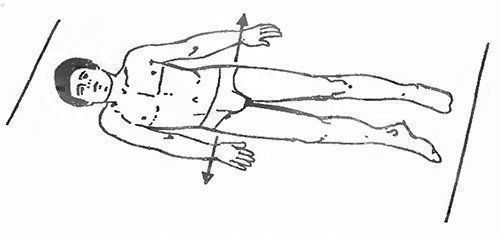
Rice. 78. Pelvic tilt to the side
By performing this exercise, you will understand the mechanism of pelvic distortion in the frontal plane. By relaxing a tense muscle and tensing a relaxed one, you can correct this disorder.
Exercise No. 3. Lateral horizontal shift of the upper body in a sitting position
Perform this exercise for self-control in front of a mirror. It consists of a horizontal displacement of the chest. In this case, you can help yourself by stretching your arm to the side and transferring your body weight to the buttock and leg of the same side.
With proper contraction of the oblique abdominal muscles, the thoracic region shifts without causing tilting or bending of the spine (Fig. 79).
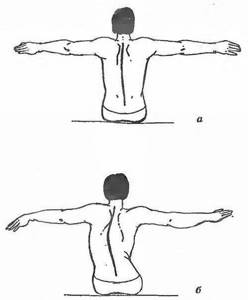
Rice. 79. Lateral horizontal displacement of the upper body in a sitting position
This exercise can significantly reduce even severe scoliosis of the thoracic spine.
Exercise No. 4. Lateral horizontal displacement of the pelvis while standing against a wall
Stand with your back to the wall, moving your feet away from it, shoulder-width apart, and slightly bending them at the knees and hip joints. The body and head fit tightly to the wall and do not take part in the movements of the pelvis.
Perform a horizontal movement of the pelvis from side to side in the plane of the wall. When performing this exercise, do not lift your pelvis off the wall (Fig. 80).
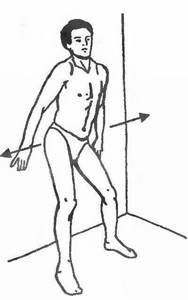
Rice. 80. Lateral horizontal displacement of the pelvis to a standing position against the wall
Exercise No. 5. Lateral horizontal displacement of the torso while standing against a wall
Having taken the pose described in exercise No. 4, shift your torso from side to side. In this case, the pelvis fits tightly to the wall and does not take part in the movement of the torso; the body does not come off the wall when performing the exercise (Fig. 81).
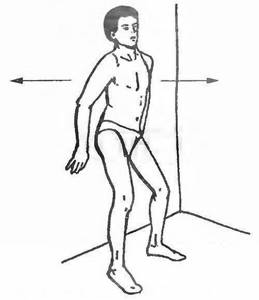
Rice. 81. Lateral horizontal displacement of the torso while standing against a wall
Exercise No. 6. Lateral horizontal displacement of the head
While sitting or standing in front of a mirror, move your head horizontally from side to side. At the same time, the head does not turn or tilt (Fig. 82).
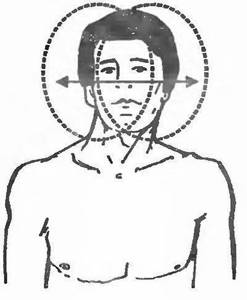
Rice. 82. Lateral horizontal displacement of the head
By learning to perform these exercises correctly, you will gain skills in correcting posture and spinal alignment.
Ideal posture: why it is important to keep your back straight
The majority of Russian residents suffer from musculoskeletal pain. And it arises from the fact that we walk, stand and sit incorrectly: this leads to problems with the central part of our skeleton - the spine. How to acquire and maintain correct posture was discussed in the program “About the Most Important Thing” on the Rossiya 1 TV channel.
Many people can still keep their back straight when they stand or walk, notes Alexander Myasnikov, but sitting people completely forget about posture: we rest cross-legged and, lounging, work - neck forward, one shoulder higher than the other, but in both cases the spine is crocheted. The muscles around it spasm and stiffen in the wrong position and are then difficult to straighten.
Seats with backs – chairs and armchairs – especially “corrupt” us. When the back finds support, the muscles relax and stop working - maintaining the spine in the correct position - and over time, they atrophy.
The doctor recommends one unusual remedy that is especially suitable for those who like to keep their hands in their pockets: put some unusual objects in one or both. And every time you come across them, remember that you need to square your shoulders and straighten your back.
Alexander Leonidovich is also surprised by the way today’s motorists sit in their cars: pushing back the seat and leaning back in it so that their legs can barely reach the pedals, and their fingers can barely reach the steering wheel. This not only harms your posture, but is also fraught with an accident: in such a position there is no need to talk about a quick reaction to an emergency traffic situation. In addition, if a car or motorcycle is shaken by a pothole, then a curved spine is a direct path to a compression fracture. You need to sit upright behind the wheel and so that your outstretched arm touches the steering wheel with the heel of your palm.
Another common mistake is lifting weights with straight legs and a bent back. When trying to straighten up from this position, spasm and pain in the lower back are guaranteed. You need to do the opposite: bend your knees and keep your back straight. In addition, if possible, weights should be carried in a backpack, and if you don’t have one, divide them equally into two bags and carry them in two hands: then the load on the spine will be at least symmetrical.
Did you know that musculoskeletal pain also includes something as common as headaches? Incorrect position of the neck leads to compression of the nerve roots, and tension in the muscles and fascia that surround the skull from the outside is felt as pain inside it. In the pelvic region we have more than 20 muscles, and each has tendons, ligaments and fascia. And the lower abdomen hurts from problems with... the spine, and not at all from inflammation of the appendages, which women “sin” for. A significant part of the studies to which cardiologists refer patients with complaints of heart pain are carried out in vain: the problem is intercostal neuralgia. With curvature of the spine, the distribution of the load on the hip joints changes - hence arthrosis...
In addition to the medical aspect, Dr. Myasnikov draws the audience’s attention to the aesthetic aspect: a person should be pleasant to look at, and posture is the first thing that catches the eye. He himself admits: when he comes into the sight of representatives of the fair sex, he straightens his shoulders and sucks in his stomach. And it tells women: a stooped back hides your breasts!




